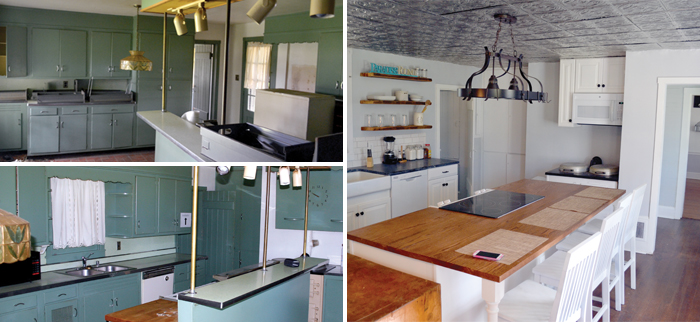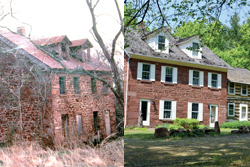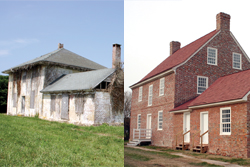If These Walls Could Talk: Maryland’s Resident Curatorship Program

Grove Farm kitchen: before and after; department photos
From the remains of Native American settlements to development undertaken by Europeans, it is difficult to find a part of Maryland that does not possess a unique story to tell. As the largest single public landowner, the Maryland Department of Natural Resources manages a huge portfolio of historically significant properties full of important archeological, architectural and natural resources.
Of these irreplaceable treasures, historic structures stand as some of the most tangible connections to our collective heritage. From high style 18th century plantations and vernacular mill worker housing to 19th century farmsteads and Civilian Conservation Corps cabins, the department fosters a broad variety of architectural resources that provide a glimpse into Maryland’s past.
| Since its start in 1982, Maryland’s Resident Curatorship Program has facilitated the restoration and maintenance of nearly 50 important historic structures throughout the state that might otherwise have been lost forever. The Quarry Master’s House in Montgomery County is an excellent example, brought back from near ruin.
It was originally built around 1830 as a duplex for quarry workers. The distinctive red stone they famously mined was used to build many local structures, including the Smithsonian Castle in Washington D.C. By the time the department purchased the property in 1976 for inclusion in Seneca Creek State Park, the house had fallen into disrepair and was nearly lost. Fortunately, Bob and Loreto Albiol became its caretakers. “This program is a phenomenal contribution to the efforts to preserve our American heritage. For it to succeed, it requires all our respect, support and appreciation.” The Quarry Master’s House is now among the most beautiful historic properties managed through the curatorship program. Thanks to their hard work, their home will stand testament for many decades to come. |

Quarry Master’s House: before and after
Effort and responsibilities
While these properties are valuable assets to society, anyone who has owned an old house can attest to the amount of energy, investment and time necessary to keep it in good working condition. Given the sheer number of properties owned by the department and the realities of its budget, restoring and maintaining all of them all simply isn’t feasible. Rather than see these sites lost and relegated to the archives of what once was, the department pioneered an innovative way to ensure their continued maintenance and preservation: the Resident Curatorship Program.
The program is relatively straightforward. Qualified individuals are selected through an open application process. Those chosen are then responsible for repairs, renovation and upkeep. In exchange, curators are given life-tenancy, rent and tax-free.
|
Available properties |
Now before you start thinking, “Wow, a free house!” remember, these properties require a significant amount of work and an investment to the tune of approximately $150,000-$300,000.
With more than 30 years of restoration experience, Bob Albiol says, “The most significant and persistent misunderstanding is that curators are, ‘getting a house for free.’ Nothing could be further from the truth. The curators, state employees and the public should appreciate that restoring and maintaining a property takes more time, money, sweat, patience and effort than one can imagine.”
Once the initial restoration is complete, curators must keep up with routine maintenance on the house and its grounds for as long as they remain. They are also asked to share the results of their labor with the general public through open houses, blog posts and other events and programs.
Throughout the entire process, the house and grounds remain the property of the state and cannot be sold or transferred to anyone else. Upon termination of a curatorship agreement, use of the property reverts to the department.
| While private citizens most often apply to become curators, sometimes nonprofit organizations take on the challenge as a collective group. The Rackliffe House at Assateague State Park became one such undertaking.
First constructed by Captain Charles Rackliffe in the mid-18th century, the property had suffered greatly as a result of fire and disinvestment. Fortunately, some interested citizens started the Rackliffe House Trust and began the monumental task of restoring the house to its former glory. Today, the Rackliffe house is open to the public for tours, special programs and events. “Visitors to are used to the beauty of the beach and the bay,” says park manager Angela Baldwin, “but they now have a new place to explore at the Rackliffe House—something very different than what they find on the island. They tell us it’s like going back in time and getting a real feel for how it would have been to have lived in a coastal plantation house so many years ago.” Adding to the visitor experience, Trust member Karen Bradley recalls, “A few staffers and I researched and acquired colonial games for the children. We teach them how to play trap ball, skittles, graces and hoops. One day, as a family was leaving the yard, I heard one of the pre-teens tell his parents they needed to get those games to play at home. It was so refreshing in this day and age!” |

Rackliffe House: before and after
Rewards
While curators never officially own the houses they are reside, the program offers a unique opportunity to live in the middle of bucolic protected lands with natural, historical and cultural amenities right outside their front door, literally.
In addition, the program includes some financial benefits. Due to the fact that the properties remain in public ownership, they are exempt from state property taxes. Depending on the size and location, this incentive can add up to significant savings, which can then be reinvested into the property. Lastly, curators can enjoy the satisfaction of knowing their efforts have led to the preservation of an important and worthwhile part of Maryland heritage.
As director of this program, what strikes me most is remembering we exist on merely a page in the history of these old houses. They still exist today because of the care given to them by their occupants, and it is incumbent upon us to continue giving that same level of care and nurture for future generations to enjoy.
Article by Peter Morrill—program manager.
Appears in Vol. 19, No. 4 of the Maryland Natural Resource magazine, fall 2016.


 1-888-373-7888
1-888-373-7888 233733
233733